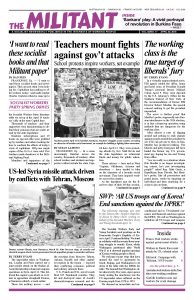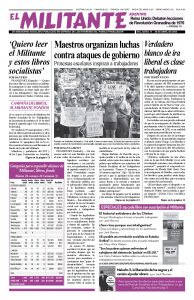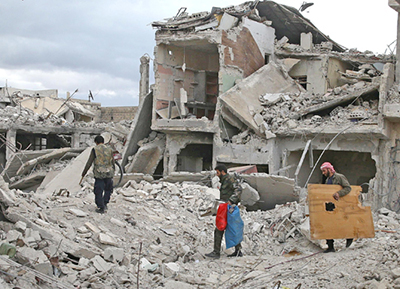The imperialist rulers in Washington, London and Paris carried out a joint missile attack on the Bashar al-Assad dictatorship’s chemical weapons operations in Syria April 13. This followed the regime’s gas attack on civilians in opposition stronghold Douma, a Damascus suburb, a week earlier.
These two military moves — and the reactions from Moscow, Tehran, Ankara, Riyadh and other capitalist regimes in the region — exposed their conflicting economic, political and military interests there.
U.S., French and U.K. naval vessels fired 105 Tomahawk missiles. They hit and destroyed some of Assad’s chemical-weapons research and development centers and storage facilities, but otherwise didn’t affect the regime. Assad began bombing opposition forces and civilian neighborhoods in Homs and Hama north of Damascus the next day.
“Mission accomplished!” President Donald Trump said, underscoring the airstrikes’ limited aim. They were intended to avoid Russian casualties and to deter Moscow’s threat, largely bluster, to shoot down U.S. and allied missiles. The week delay in launching the attack meant Assad had time to move his air fleet and other weaponry to Russian bases, safe from attack.
Spokespeople for Moscow have claimed that the April 7 gas attack either never happened, or was carried out by opposition forces seeking to smear Assad. They also accused London of masterminding a “fake” chemical attack.
The president feigned concern for the Syrian people, describing Assad’s use of chemical weapons as “barbarism.” The U.S. rulers are no strangers to barbarism — in the Vietnam War they dropped massive amounts of napalm, a mixture of gasoline and gel that sticks to people’s bodies and generates temperatures of 1,500°F. The Pentagon dropped 690,000 tons of napalm in one hour on Tokyo in 1945, killing some 100,000 people. Washington also used napalm in Korea.
And Washington is the only government to use nuclear weapons, devastating Hiroshima and Nagasaki at the end of the second imperialist world war.
Moscow, Tehran shore up Assad’s rule
Assad turned to Moscow and Tehran-backed militias to shore up his rule when massive repression failed to extinguish a popular rebellion that broke out in 2011 against his tyranny. Throughout the subsequent civil war he has used chemical weapons and barrel bombs on civilian populations, as well as sieges to starve opponents into submission.
Hours after its poisonous attack on Douma, in eastern Ghouta, opposition forces there surrendered to Assad’s forces and Russian troops. Since then, over 160,000 people have been bused from eastern Ghouta to northern Syria. Russian military police were deployed to Douma once opposition forces left.
Moscow has expanded its military and political influence in the region during the civil war, something Washington seeks to reverse. The U.S. rulers’ central goal is to push back against gains made by the counterrevolutionary regime in Tehran. The Iranian rulers and their allies in Hezbollah have set up bases in Syria, established a land bridge between Iran and Lebanon, and threaten to launch attacks against Israel.
Tel Aviv launched an airstrike on an Iranian base in Syria April 8, killing seven Iranians. This “was the first time we attacked live Iranian targets — both facilities and people,” an Israeli military source told the New York Times.
The U.S. rulers are trying to find a way to constrain the rising clout of Tehran and Moscow across the region, without committing large numbers of U.S. troops to combat operations. Washington currently has some 2,000 troops in Syria, and tens of thousands more at bases throughout the Mideast. Along with their Kurdish-led Syrian Democratic Forces ally, Washington controls some 25 percent of the country.
The Trump administration is pressing Arab allies to send troops to Syria. Saudi Foreign Minister Adel al-Jubeir said the monarchy there is willing to do so. Washington has approached the governments in Qatar, the United Arab Emirates and Egypt as well.
If the administration succeeds, Trump hopes to reduce U.S. troop deployment in Syria. “No amount of American blood or treasure can produce lasting peace and security in the Middle East,” he said April 13. “It’s a troubled place.”
But it has been Washington’s brutal wars in the Mideast over decades, alongside the intervention of rival powers, that have intensified sectarian conflicts and the social crisis imposed on working people by the region’s capitalist rulers.


